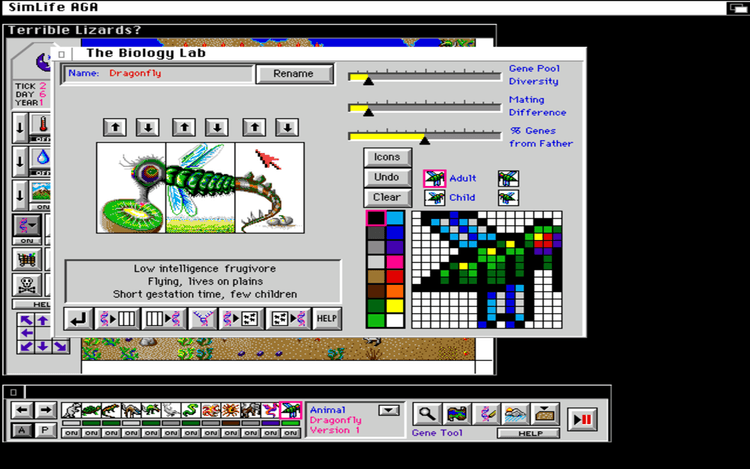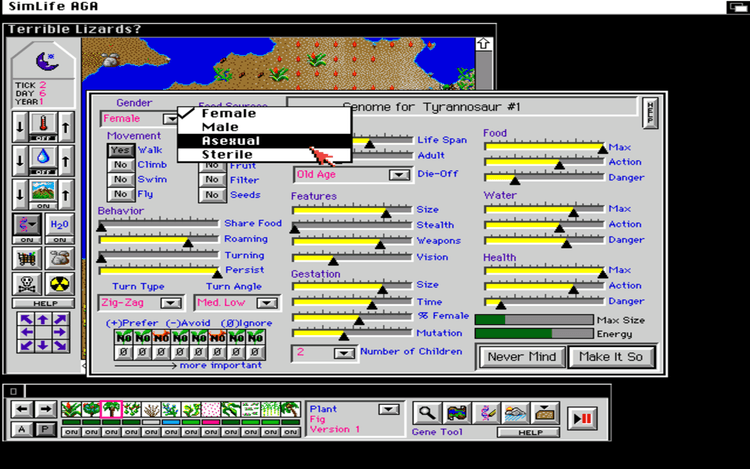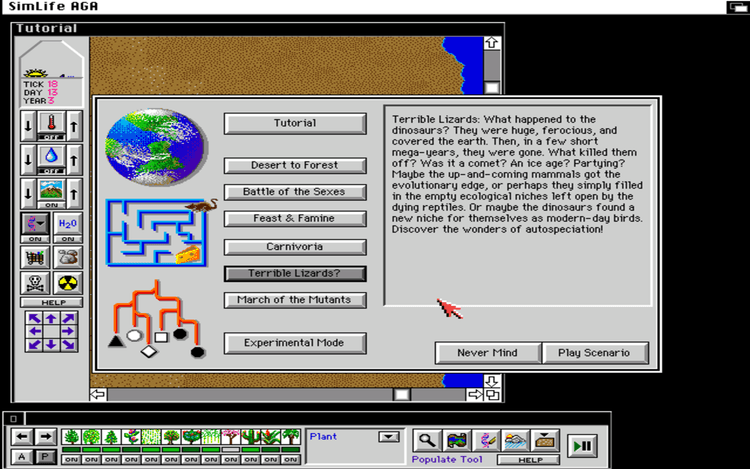
SimLife is a life simulation game from Maxis that lets you design ecosystems, tweak genetics and watch strange species emerge over time. You can play SimLife online and experiment with plants, animals and environments like a digital sandbox of evolution. Fans of SimEarth and SimCity will feel at home managing complex systems, while strategy players who enjoy games like Civilization will appreciate the long-term planning and experimentation. With its open-ended experiments, charming visuals and unpredictable results, this classic game invites you to play, observe and reshape virtual life again and again.
SimLife is a classic life simulation game created by Maxis, the studio famous for turning “software toys” into global successes. Emerging from the same creative era that produced SimCity and SimEarth, this game shifts the focus from cities or planets to the tiny, intricate web of life itself. Instead of laying roads or zoning districts, you guide evolution, adjust genetic codes and watch creatures adapt, thrive or vanish as environments change around them. It sits right at the crossroads between educational software and sandbox game, inviting players to experiment rather than chase a fixed objective.
From the moment the title screen appears, SimLife makes its philosophy clear: this is a world where you are not a traditional hero but a curious architect of nature. Maxis designed it to feel like a digital laboratory and a playful ecosystem at the same time. The DOS version captures that blend with colorful sprite-based graphics, evocative icons and clear interface panels that make complex simulations approachable. Even today, the core design feels timeless, because the underlying themes—evolution, adaptation and ecological balance—never really age.
At its heart, SimLife is about creating and managing ecosystems. You place terrain, control climate, and populate the world with plants and animals that each have their own needs and behaviors. Some species might be hardy desert survivors, others delicate forest dwellers that wilt with small changes in temperature or rainfall. As you play the game, you will see populations rise and fall, new patterns emerge and sometimes entire regions collapse under poor management or extreme experiments.
The simulation encourages careful observation. You do not simply issue commands and wait for a victory screen; instead, you watch food chains, track breeding success and monitor how species migrate across your landscape. The joy of the game lies in seeing emergent behavior. Perhaps an herbivore becomes too successful and strips your world of vegetation, leading to a crash. Perhaps a subtle climate shift gives a previously minor plant the chance to dominate. Every scenario feels like a dynamic, living puzzle.
One of SimLife’s most distinctive features is the way it lets you manipulate genetics. You can open up a species and adjust traits such as fertility, lifespan, diet and resistance to environmental stress. With a few changes, a fragile creature can become a hardy survivor, or a once-stable population can spiral into chaos. The game does not force a single “correct” solution; instead, it rewards curiosity and experimentation. In many ways, it feels like a precursor to later sandbox games that let players define their own success.
Despite the complexity of its underlying model, SimLife presents its tools through a clear, icon-driven interface. Menus and windows let you switch between map views, data charts and genetic editors. The pacing is fully under your control: you can speed up time to watch generations pass quickly, or slow things down to study what happens when you introduce a new predator or alter rainfall patterns. There is a satisfying rhythm to switching between the big-picture world map and the fine detail of individual species.
The game offers premade scenarios as well as open-ended worlds. Some scenarios challenge you to stabilize a fragile ecosystem, while others encourage you to pursue wild genetic experiments, pushing evolution in unusual directions. In a free-play setting, SimLife becomes almost meditative, as you tweak variables, observe changes and slowly come to understand how each system interacts. The experience resembles playing with a biological model set rather than following a traditional campaign.
The sound and presentation are deliberately straightforward, allowing the simulation itself to be the star. Simple audio cues and minimalist music never overwhelm the interface, and the pixel art has a certain charm that fits the scientific-toy aesthetic. Because the game relies more on systems than spectacle, it remains engaging long after more graphically advanced titles fade from memory.
Because SimLife is a classic DOS game, it can be enjoyed today through emulation, letting you play SimLife online without needing vintage hardware. The underlying design translates smoothly to a browser-based experience, where the mouse-driven interface and windowed panels feel right at home. You can run experiments, adjust genetics and watch the simulated ecosystems evolve directly in your browser.
This makes it easy to jump into the game for a quick evolutionary test or a longer, more involved experiment. The same qualities that made SimLife appealing in its original release—open-ended play, scientific flavor and creative freedom—work just as well when accessed online. You can play it free, without restrictions, and the straightforward controls adapt very well to both desktop and mobile devices. Touch input maps naturally to the game’s pointer-driven design, so experimenting with species, terrain and climate settings feels intuitive even on a smaller screen.
Being able to load up SimLife online wherever you are turns it into a portable laboratory of life. Whether you want to run a short lesson in ecology, conduct a series of genetic tests or simply watch an ecosystem rise and fall, the game fits easily into small pockets of time. This flexibility reinforces SimLife’s identity as both a game and an endlessly replayable simulation toy.
SimLife may not have traditional missions or a story-driven campaign, but it offers a surprising amount of strategy. Managing limited resources, balancing food chains, designing resilient species and avoiding runaway population booms all require careful planning. Players who enjoy thinking several steps ahead will find plenty to analyze as they try to guide evolution along a desired path.
Replay value comes from the sheer number of variables you can adjust. Change the climate model, alter the starting species, rewrite genetic traits or build a landscape of extreme contrasts, and you will get a different experience every time. One session might focus on creating a stable, harmonious ecosystem; another might be about pushing conditions to the edge and watching what happens when nature is stressed to the limit. Because there is no single “right” way to play, experimentation never really runs out.
SimLife is especially appealing to players who like thoughtful simulations and sandbox experiences. Fans of titles such as SimCity, SimEarth or other god games will appreciate the sense of control over invisible systems. At the same time, anyone curious about evolution, ecology or genetics can use the game as a playful entry point into those concepts. It invites both casual curiosity and deep, methodical exploration.
In terms of controls, SimLife is primarily driven by the mouse and simple keyboard shortcuts. You use the mouse to select tools, place terrain, adjust sliders and open species panels. Keyboard keys can be used for pausing, changing simulation speed and switching between views. The layout is intuitive enough that even newcomers to DOS-era games can grasp the basics quickly, while advanced players can dive into more detailed menus and genetic editors.
SimLife stands as a distinctive classic that turns complex biological ideas into an accessible, engaging game. Its combination of sandbox freedom, strategic depth and educational value makes it rewarding to revisit, whether for nostalgic reasons or fresh experimentation.
All used codes are publicly available, and the game SimLife belongs to its original authors and rights holders.
Share game
Share game




Share game